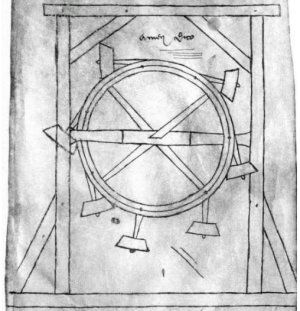A Brief History of Perpetual Motion [Hackaday]

Conservation of energy isn’t just a good idea: It is the law. In particular, it is the first law of thermodynamics. But, apparently, a lot of people don’t really get that because history is replete with inventions that purport to run forever or produce more energy than they consume. Sometimes these are hoaxes, and sometimes they are frauds. We expect sometimes they are also simple misunderstandings.
We thought about this when we ran across the viral photo of an EV with a generator connected to the back wheel. Of course, EVs and hybrids do try to reclaim power through regenerative braking, but that’s recovering a fraction of the energy already spent. You can never pull more power out than you put in, and, in fact, you’ll pull out substantially less.
Not a New Problem
If you think this is a scourge of social media and modern vehicles, you’d be wrong. Leonardo da Vinci, back in 1494, said:
Oh ye seekers after perpetual motion, how many vain chimeras have you pursued? Go and take your place with the alchemists.
There was a rumor in the 8th century that someone built a “magic wheel,” but this appears to be little more than a myth. An Indian mathematician also claimed to have a wheel that would run forever, but there’s little proof of that, either. It was probably an overbalanced wheel where the wheel spins due to weight and gravity with enough force to keep the wheel spinning.

An architect named Villard de Honnecourt drew an impractical perpetual motion machine in the 13th century that was also an overbalanced wheel. His device, and other similar ones, would require a complete lack of friction to work. Even Leonardo da Vinci, who did not think such a device was possible, did some sketches of overbalanced wheels, hoping to find a solution.
Types of Machines
There isn’t just a single kind of perpetual motion machine. A type I machine claims to produce work without any input energy. For example, a wheel that spins for no reason would be a type I machine.
Type II machines violate the second law of thermodynamics. For example, the “zeromoter” — developed in the 1800s by John Gamgee, used ammonia and a piston to move by boiling and cooling ammonia. While the machine was, of course, debunked, Gamgee has the honor of being the inventor of the world’s first mechanically frozen ice rink in 1844.
Type III machines claim to use some means to reduce friction to zero to allow a machine to work that would otherwise run down. For example, you can make a flywheel with very low friction bearings, and with no load, it may spin for years. However, it will still spin down.
Often, machines that claim to be perpetual either don’t really last forever — like the flywheel — or they actually draw power from an unintended source. For example, in 1760, James Cox and John Joseph Merlin developed Cox’s timepiece and claimed it ran perpetually. However, it actually drew power from changes in barometric pressure.
Frauds
These inventions were often mere frauds. E.P. Willis in 1870 made money from his machine but it actually had a hidden source of power. So did John Ernst Worrell Keely’s induction resonance motion motor that actually used hidden air pressure tubes to power itself. Harry Perrigo, an MIT graduate, also demonstrated a perpetual motion machine to the US Congress in 1917. That device had a secret battery.
However, some inventors probably weren’t frauds. Nikola Tesla was certainly a smart guy. He claimed to have found a principle that would allow for the construction of a Type II perpetual motion machine. However, he never built it.
There have been hosts of others, and it isn’t always clear who really thought they had a good idea and how many were just out to make a buck. But some people have created machines as a joke. Dave Jones, in 1981, created a bicycle wheel in a clear container that never stopped spinning. But he always said it was a fake and that he had built it as a joke. Adam Savage looks at that machine in the video below. He wrote his secret in a sealed envelope before he died, and supposedly, only two people know how it works.
Methods
Most perpetual machines try to use force from magnets. Gravity is also a popular agent of action. Other machines depend on buoyancy (like the one in the video below) or gas expansion and condensation.
The US Patent and Trademark Office manual of patent examining practice says:
With the exception of cases involving perpetual motion, a model is not ordinarily required by the Office to demonstrate the operability of a device. If operability of a device is questioned, the applicant must establish it to the satisfaction of the examiner, but he or she may choose his or her own way of so doing.
The UK Patent Office also forbids perpetual motion machine patents. The European Patent Classification system has classes for “alleged perpetua mobilia”
Of course, having a patent doesn’t mean something works; it just means the patent office thought it was original and can’t figure out why it wouldn’t work. Consider Tom Bearden’s motionless electromagnetic generator, which claims to generate power without any external input. Despite widespread denouncement of the supposed operating principle — Bearden claimed the device extracted vacuum energy — the patent office issued a patent in 2002.
The Most Insidious
The best machines are ones that use energy from some source that isn’t apparent. For example, a Crookes radiometer looks like a lightbulb with a little propeller inside. Light makes it move. It is also a common method to use magnetic fields to move something without obviously spinning it. For example, the egg of Columbus (see the video below) is a magnet, and a moving magnetic field makes the egg spin. This isn’t dissimilar from a sealed pump where a magnet turns on the dry side and moves the impeller, which is totally immersed in liquid.
Some low-friction systems, like the flywheel, can seem to be perpetual motion machines if you aren’t patient enough. But eventually, they all wear down.
Crazy or Conspiracy?
Venues like YouTube are full of people claiming to have free energy devices that also claim to be suppressed by “the establishment”. While we hate to be on the wrong side of history if someone does pull it off, we are going to go out on a limb and say that there can’t be a true perpetual motion machine. Unless you cheat, of course.
This is the place we usually tell you to get hacking and come up with something cool. But, sadly, for this time we’ll entreat you to spend your time on something more productive, like a useless box or put Linux on your Commodore 64.
